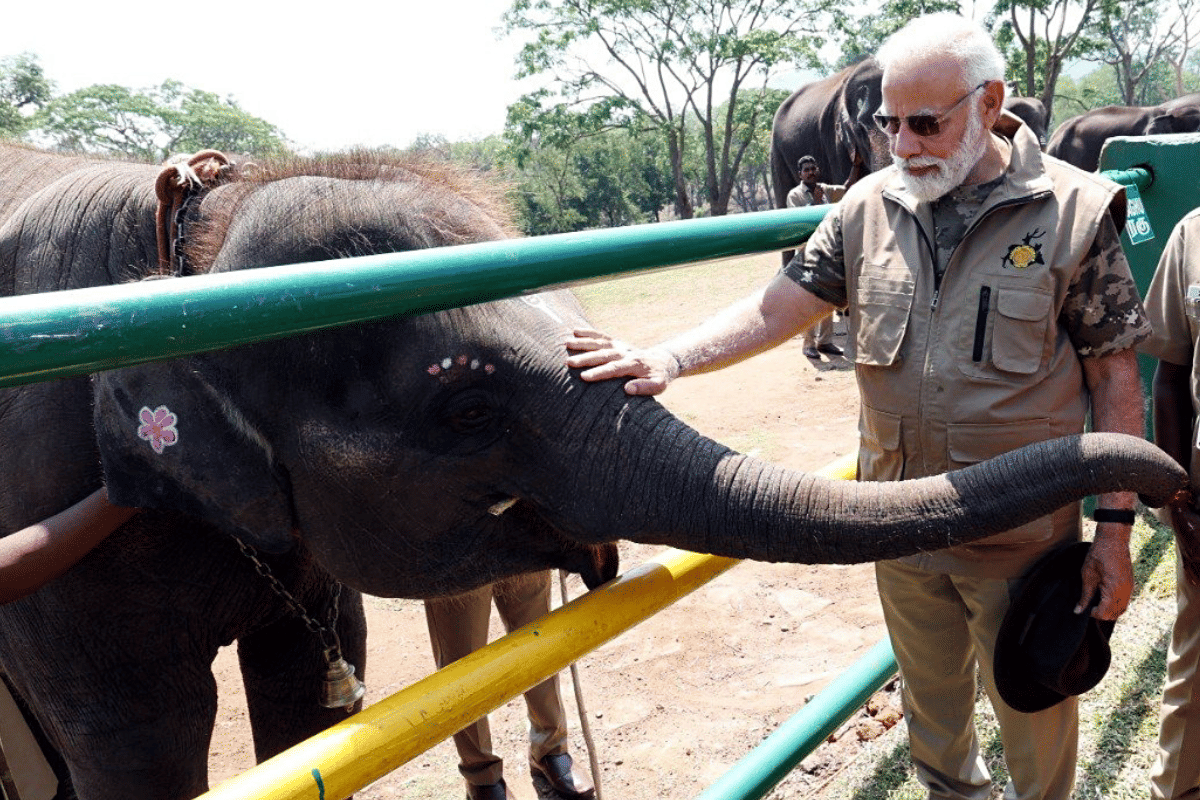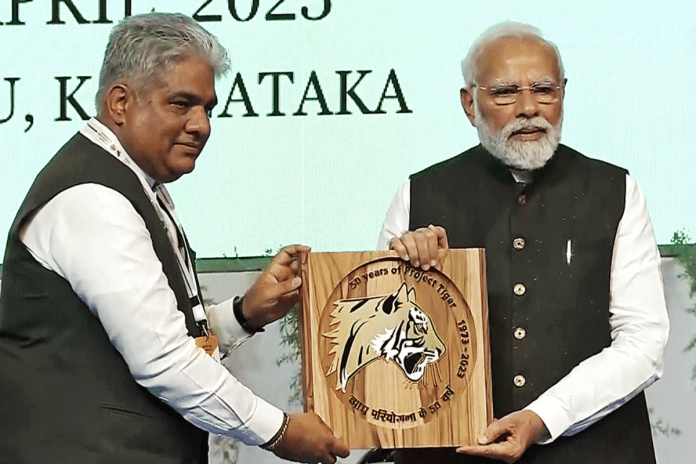New Delhi: Standing at 3,167 as of 2022, India’s tiger population has grown by at least 200 since 2018, Prime Minister Narendra Modi announced Sunday as he released the latest tiger census in Karnataka.
During celebrations commemorating 50 years of ‘Project Tiger’ at Karnataka State Open University, Mysuru, the Prime Minister said, “It has been 50 years since Project Tiger, which is a matter of pride, not only for India, but the whole world.”
Apart from the tiger census report, titled the ‘Status of Tigers 2022’, Modi also released the fifth cycle of Management Effectiveness Evaluation (MEE), an annual assessment that accompanies the tiger census in India.
In addition, the PM also released a commemorative coin marking 50 years of ‘Project Tiger’, and the government’s vision for tiger conservation during the ‘Amrit Kaal’.

PM Modi at Theppakadu elephant camp in Mudumalai Tiger Reserve Sunday | ANIThe PM said that India has given tigers an ecosystem in which they can flourish, and added that it was necessary for the world to come together for the protection of big cats. The Prime Minister had visited Bandipur and Mudhumalai Tiger reserves before attending the launch in Mysuru Sunday.
According to the National Tiger Conservation Authority (NTCA), India is home to over 70 per cent of the world’s tigers. Since 2006, every passing census shows a steady increase in tiger population – 1,411 (2006), 1,706 (2010), 2,226 (2014), 2,967(2018), and 3,167 as of 2022.
The estimate — considered as the “minimum population,” — was arrived at after examining camera traps, trails and total habitat as well as by conducting surveys on foot.
Bhupender Yadav, Minister of Environment and Climate Change, who was present at the event, said India’s conservation efforts have led to the number of tiger reserves swelling to 53, of which 23 are “internationally accredited”.
The tiger population has risen “substantially” in the Shivalik Hills and Gangetic floodplain, while it has shrunk in the Western Ghats due to “the rise in development work— leading to an increasing overlap between wildlife and humans”, said the ‘Status of Tigers 2022’ report.
Calling for the protection of big cats worldwide, Modi also launched the “International Big Cat Alliance (IBCA)” during the celebrations. The objective of the initiative is to conserve and protect seven species — tigers, leopards, cheetahs, lions, snow leopards, pumas and jaguars — and create a platform that will benchmark big cat conservation practices and act as a repository of technical knowledge and funds for conservation.
It envisions collaboration of 97 countries that inhabit the seven cat species and is “open for other interested countries and international organisations that are willing to contribute to IBCA’s objectives, the PM said.
Also Read: From January to June, wildlife board gave permits that can be ‘disastrous’ for protected areas
Future of tiger conservation in India
Although praise for ‘Project Tiger’ rang high during Sunday’s event, the census report released by the PM paints a mixed picture of the future of tiger conservation in India.
According to wildlife experts, the growth of the tiger population needs to be monitored closely to avoid man-animal conflicts. Growth in India’s tiger population also comes at a time when forests and other protected ecosystems are being cleared for development projects in parts of the country, leading to habitat fragmentation.

“Although some habitat corridors exist that allow tiger movement between them, most of these habitats are not protected areas. These areas continue to deteriorate further due to unsustainable human use and developmental projects and are, therefore, not conducive to animal movement,” said the report.
Meanwhile, the number of India’s other big cats, including Asiatic lions, has also increased.
In 2020, the number of Asiatic lions was 674, up from 523 reported in 2015. The number of leopards, meanwhile, has gone up to 12,852 in 2018 from 7,910 in 2014, the PM said.
“We don’t believe the ecology and the economy are in conflict with each other. We instead see them coexisting,” Modi said during his speech.
Last year and early this year, India introduced 20 African cheetahs to Kuno National Park in Madhya Pradesh — the first trans-continental translocation programme of its kind. One cheetah has since died due to a kidney ailment.
(Edited by Richa Mishra)
Also Read: Corbett beyond tiger safaris — explore it for different animal sightings & experiences






